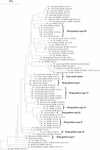Phylogeny of the genus Nocardia based on reassessed 16S rRNA gene sequences reveals underspeciation and division of strains classified as Nocardia asteroides into three established species and two unnamed taxons
- PMID: 12574299
- PMCID: PMC149683
- DOI: 10.1128/JCM.41.2.851-856.2003
Phylogeny of the genus Nocardia based on reassessed 16S rRNA gene sequences reveals underspeciation and division of strains classified as Nocardia asteroides into three established species and two unnamed taxons
Abstract
Conventional identification of Nocardia in the routine laboratory remains problematic due to a paucity of reliable phenotypic tests and due to the yet-unresolved taxonomy of strains classified as belonging to the species Nocardia asteroides, which comprises the type strain and isolates with drug pattern types II and VI. The 16S rRNA gene of 74 representative strains of the genus Nocardia, encompassing 25 established species, was sequenced in order to provide a molecular basis for accurate species identification and with the aim of reassessing the phylogeny of taxons assigned to the species N. asteroides. The result of this phylogenetic analysis confirms that the interspecies heterogeneity of closely related nocardial species can be considerably low (a sequence divergence of only 0.5% was found between N. paucivorans and N. brevicatena). We observed a sequence microheterogeneity (sequence divergence of fewer than five bases) in 8 of 11 species of which more than one strain in the species was studied. At least 10 taxons were found that merit description as new species. Strains previously classified as N. asteroides fell into five distinct phylogenetic groups: the type strain cluster (N. asteroides sensu strictu), N. abscessus, N. cyriacigeorgica, and two clusters closely related to N. carnea or N. flavorosea. The strains within the latter two groups probably represent new species, pending further genetic and phenotypic evaluation. Restricted phenotypic data revealed that N. abscessus, N. cyriacigeorgica, and the two Nocardia species taxons are equivalent to drug patterns I, VI, and II, respectively. In the future, these data will help in finding species-specific markers after adoption of a more precise nomenclature for isolates closely related to N. asteroides and unravel confusing phenotypic data obtained in the past for unresolved groups of strains that definitely belong to separate taxons from a phylogenetic point of view.
Figures

References
-
- Baracco, G. J., and G. M. Dickinson. 2001. Pulmonary nocardiosis. Curr. Infect. Dis. Rep. 3:286-292. - PubMed
-
- Brown, J. M., M. M. McNeil, and E. P. Desmond. 1999. Nocardia, Rhodococcus, Gordona, Actinomadura, Streptomyces, and other actinomycetes of medical importance, p. 370-398. In P. R. Murray, E. J. Baron, M. A. Pfaller, F. C. Tenover, and R. H. Yolken (ed.), Manual of clinical microbiology, 7th ed. ASM Press, Washington, D.C.
-
- Chun, J., and M. Goodfellow. 1995. A phylogenetic analysis of the genus Nocardia with 16S rRNA gene sequences. Int. J. Syst. Bacteriol. 45:240-245. - PubMed
MeSH terms
Substances
LinkOut - more resources
Full Text Sources
Other Literature Sources
Molecular Biology Databases
Miscellaneous

